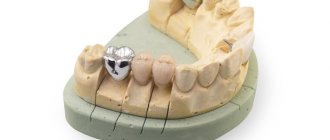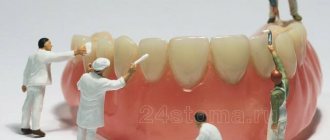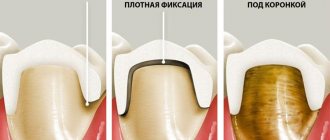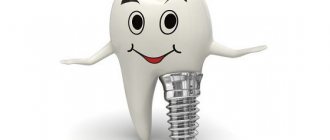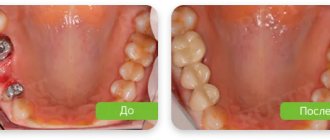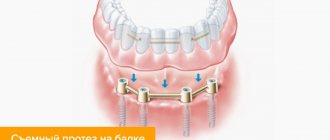1174
For some people, high-quality prosthetics is quite an expensive process. But this does not mean that it is impossible to recreate missing teeth inexpensively.
Bridge-like structures made of plastic, in comparison with other analogue products, although they cannot be called high-quality, in many situations they allow a person to restore the dentofacial apparatus and regain self-confidence, albeit not for long.
General overview
A plastic bridge is a non-removable orthopedic structure. Structurally, such a prosthesis is represented by the following elements:
- Two crowns that are placed on the supporting teeth (healthy and stable elements that can withstand constant chewing load, or implants, are always used as supports).
- Intermediate part , consisting of artificial dental units (1-4 pieces) and filling the gap in the dentition.
The material itself is endowed with the following characteristics:
- easily destroyed;
- deformed;
- has low cost;
- unesthetic;
- not strong enough;
- absorbs foreign odors well;
- changes color when exposed to food coloring;
- favorable for the proliferation of pathogenic microflora due to its porosity.
Based on the listed indicators, bridges are recommended for prosthetics of small defects in the lateral and frontal sections that are the result of pathological changes in hard tissues, trauma, or anomalies in position and shape.
But due to the emergence of more technologically advanced materials, plastic prostheses began to be used for temporary prosthetics . For the same reason, it is not recommended to reconstruct missing molars.
Important! Only in the absence of one of the molars, with bilateral support provided, is the bridge allowed to be installed, but it gives only a relatively reliable effect.
Can an allergy to plastic crowns occur and how to prevent its occurrence.
Come here if you are interested in the price of dental prosthetics in Heihe.
At this address https://zubovv.ru/protezirovanie/nesemnyie-p/vazhnoe-o-sostavnyih-mostovidnyih.html we will consider the components of a bridge prosthesis.
Installation
The clinical stages of installing plastic bridges are as follows:
- The situation is assessed, after which a decision is made to install this particular type of structure.
- After this, preparatory measures are carried out, which include examination of the oral cavity and treatment of any history of diseases that could create an obstacle to the subsequent installation of the bridge.
- It is necessary to prepare the teeth that act as a support for the structure.
- An impression is made and sent to a dental laboratory to make a denture.
- The finished product is tried on and if there are no inaccuracies or defects, then it is installed.
- If the structure is used as a permanent prosthesis, it is fixed with cement. Removable ones are simply secured with special hooks.
Plastic products are characterized by minimal weight and do not put pressure on supporting teeth and gums. Thanks to this, the process of getting used to them proceeds as quickly as possible.
Types of structures
Bridges differ from each other in many respects. Thus, according to the method of positioning the intermediate part of the structure relative to the gum mucosa, three types of connections are distinguished:
- Flushing. It requires the presence of a small space between the product and the soft tissues (on the lower jaw this space is larger than on the upper jaw).
Thanks to the technique, small food debris can move freely under artificial teeth. But, it becomes more difficult to carry out hygienic measures without the use of additional devices, but it simplifies the implementation of professional hygienic cleaning. - Tangent. It involves touching the body of the bridge to the mucous membrane on one side. It is used mainly in the restoration of frontal elements in order to improve the overall aesthetics of the rows and maintain the correct pronunciation.
- Saddle-shaped. This type of connection implies a tight connection between the bridge and the mucosa.
From the point of view of the quality of oral care and strength indicators, it is not the best option. The saddle type connection is usually used in combination with the tangent method in the reconstruction of anterior teeth.
Based on the type of support, bridge structures are divided into types:
- Single-sided (console).
- Double-sided.
- With lock fastening.
- On implants.
In the first case, bridges have support on only one side, which is usually located distal to the area being restored. The use of such structures is possible when replacing frontal units, provided that the periodontium is in normal condition and is resistant to constant chewing loads.
It is not recommended to install cantilever bridges in the area of chewing teeth due to the possibility of functional overload of periodontal tissues and the inability to ensure full functionality of the prosthesis.
The second option for prosthetic products in prosthetics is more preferable. Such bridges have supporting elements that limit the defect area on both sides. Bilateral bridges are more resistant to high chewing loads.
A bridge with a locking fastening does not involve the involvement of supporting teeth. In this case, the prosthesis is fixed using a lock - a high-precision collapsible connection consisting of two parts - a male and a matrix.
One part is built into the body of the bridge, and the other is placed using an adhesive technique into the hard tissues of the coronal part of the tooth, or is fixed in the root.
An important advantage of this method of securing the prosthesis is the ability to independently remove it from the mouth. Putting the product back is also not particularly difficult.
The use of bridges supported by implants is relevant if it is necessary to restore the outermost teeth in a row, more than three consecutive elements, or to recreate a dentition with complete edentia.
In this case, the functionality of the dentofacial apparatus is completely restored , and the aesthetics of the dentition is at a decent level.
Important! Prosthetics on implants is a long and complex process with a large list of contraindications.
Types of prosthesis
Based on the location of the orthodontic product to the gum, the following types are distinguished:
- tangent. Part of the structure is adjacent to the mucosa, which helps when installing a bridge on the front teeth,
- saddle-shaped. The bridge is in fairly close contact with the gum. This type is rarely used, but sometimes it is irreplaceable,
- flushing A small space is left between the gum and the denture, which prevents food from getting stuck and makes it easier to care for the structure.
Depending on the type of support, there are types of prostheses:
- unilateral. Used for prosthetics of the frontal group of the dentition,
- bilateral,
- on implants,
- with lock fastening.
Plastic bridges have a metal frame and crowns made of composite resin. The second method of creating a combined orthodontic structure involves covering the supporting elements of the entire body of the product with facing plastic.
The fragility of plastic bridges forces dentists to abandon the use of this type of product.
Indications and restrictions
For prosthetics of any type of bridge structures, certain indications must be present; plastic bridges are no exception.
It is recommended to place these products in the following conditions:
- small and medium-sized defects in the dentition, including from 1 to 4 units;
- restoration of damaged teeth due to injury or dental pathologies;
- the impossibility of eliminating the aesthetic defect by other means;
- while waiting for the creation of a permanent bridge.
Installation of a plastic bridge is contraindicated if the patient’s medical history reveals the following pathologies:
- incorrect occlusion;
- allergy to the material;
- chronic pathologies;
- neuropsychiatric disorders;
- severe damage to periodontal tissues;
- unsatisfactory hygienic condition of the oral cavity;
- insufficient thickness of hard tissues of supporting teeth;
- drug or alcohol addiction.
It is also not recommended to carry out prosthetics during pregnancy, childhood and adolescence due to insufficient strength of the dental tissue.
Construction of a plastic bridge
Bridges include two crowns, called abutments. The intermediate part must be securely fastened to the supporting part. Crowns used for supporting teeth are usually hollow, but can protect a plastic denture from unwanted movement.
The designs are often used due to the following advantages:
- maintaining the aesthetics of the dentition;
- possibility of installation on implants and stump inlays;
- minimum adaptation period;
- the ability to select the appropriate type of material.
During the installation of permanent structures, careful preparation is required. This includes grinding healthy teeth up to 2 millimeters and depulpation. In case of installation of plastic products, grinding of teeth is not performed.
Oksana ShiikaDentist-therapist
Plastic prostheses, in comparison with others, cannot be classified as high-quality, so they are used mainly as temporary substitutes.
All the pros and cons
In modern dentistry, despite the availability of high-quality materials, plastic continues to be used for the manufacture of orthopedic products, including bridge structures.
The reasons for this are the following advantages:
- low cost;
- ease of manufacture;
- ease of installation;
- light weight;
- there is no negative effect on tooth tissue and gum mucosa;
- acceptable restoration of aesthetics and functionality of the dentofacial apparatus during the creation of a permanent bridge;
- no discomfort when wearing;
- resistant to temperature fluctuations;
- short adaptation period;
- no side effects.
Among the disadvantages are the following indicators:
- insufficient strength;
- short-term operation;
- possible manifestation of allergies;
- the porosity of the material causes active reproduction of pathogenic microflora;
- quick washability of the material;
- no resistance to regular chewing load;
- require high-quality and regular hygiene using special products;
- easily damaged by hard products and abrasives;
- possible damage to fasteners;
- rapid change in original color under the influence of food coloring.
Despite the significant disadvantages of plastic bridges, their demand in dental orthopedics does not decrease.
Why soldered bridges are becoming a thing of the past.
In this publication, we will consider the properties of glass ionomer cement for fixation of crowns and bridges.
Here https://zubovv.ru/protezirovanie/nesemnyie-p/koronki-np/zolotyie-effektivnoe.html find out how much a gold crown per tooth costs today.
A few words about prices
As mentioned above, plastic crowns and removable orthopedic systems are the most budget-friendly. How much does a crown cost for one tooth? The price starts from a thousand rubles. At the same time, a metal-plastic model can cost 5-6 thousand rubles. But a complete structure supported by implants will cost at least 110 thousand rubles. The final cost will also depend on the method of creating the product.
As for removable prosthetics, prices can vary greatly - the initial clinical picture and the level of prestige of the dental clinic play an important role in the pricing issue.
Manufacturing Basics
Creating a bridge from plastic is a multi-step process, which means the patient will have to visit the orthopedic dentist several times.
It all starts with a visual examination of the oral cavity and several diagnostic examinations - radiography, orthopantomography.
If inflammation or dental pathologies are detected during examination, appropriate therapy must be prescribed. If necessary, professional dental cleaning may be necessary.
At the next visit, the supporting teeth are prepared. The procedure must be performed under local anesthesia. Depulpation is performed only if there are certain indications.
The process of making a bridge prosthesis itself includes the following steps:
- Taking impressions from both jaws.
- Creating a model from plaster, according to which the technician forms the frame and body of the future bridge
- Trying on the frame on which the wax model will be made.
- The wax model is plaster and then replaced with plastic.
- Once the plastic has hardened, the structure is polished (but this process is not completed so that adjustments can be made, if necessary, after fitting).
- Second fitting. The finished product is attached to the supporting elements, and using a copy sheet, the accuracy and correctness of contact of all teeth during eating is checked.
- Final polishing of the bridge (if there is no need to rework it).
- Transfer of the finished structure to the clinic for installation.
Despite the fact that in most cases, plastic bridges are used as temporary structures, their creation is approached responsibly and seriously.
The finished products are similar to natural teeth, completely repeat their anatomy and features, which is why they cause virtually no discomfort when worn.
For manufacturing, only high-quality plastic is used, usually of the Sinma-M or Simna-74 brands. (made in Slovenia-Liechtenstein) deserves the attention of specialists
Adjustment time
The period of adaptation to bridge prostheses directly depends on its type. Thus, the non-removable structure will no longer remind you of itself three days after its installation. Adapting to removable products is much more difficult. This period can last up to half a month.
Why can our articles be trusted?
We make health information clear, accessible and relevant.
- All articles are checked by practicing doctors.
- We take scientific literature and the latest research as a basis.
- We publish detailed articles that answer all questions.
No specialist can say the exact timing of addiction. This process is individual and depends on a number of factors:
- dimensions ;
- characteristic features of the transmission of chewing pressure;
- the chosen method and degree of fastening of the product;
- reaction to a foreign body in the oral cavity.
Dentures with suction cups
Modern dentistry has come a long way in recent decades.
After installation of the prosthesis, patients are advised to take food more seriously for some time and follow these rules:
- for two weeks, eat exclusively pureed, liquid food and cereals;
- Avoid putting stress on the dentures. Eliminate crackers, dried fruits and other hard foods from the diet;
- gradually, in the process of habituation, include more solid foods in the diet.
In some cases, when wearing dentures regularly, scratches and inflammation may form on the mucous membrane of the gums. In this case, you should make sure that the structure is put on correctly. The easiest way to do this is to look at it in front of a mirror.
In exceptional cases, patients may experience a gag reflex in the process of getting used to a foreign body in the oral cavity. To get rid of this phenomenon, experts recommend performing the following manipulations:
- perform deep breathing exercises through the nose;
- rinse your mouth with a weak salt solution;
- suck on lollipops as often as possible .
Repair of dentures
A broken prosthesis is not a rare situation and occurs in 10 percent of orthopedic treatment cases.
If there is a violation of diction, then the patient must follow these recommendations:
- read aloud, but very slowly and quietly;
- only after quiet speech has been mastered, increase the tone;
- pay special attention to the pronunciation of consonants ;
- read as often as possible (up to ten times a day), but only for five, maximum ten minutes.
Speech in most cases is restored within 2 weeks. Depending on individual characteristics, this period may be longer.
There are a number of additional recommendations, following which the process of getting used to the prosthesis can be significantly accelerated:
- regularly clean the denture and massage the gums, followed by rinsing the mouth;
- resort to the use of fixing agents in cases where the structure is not very stable;
- strictly follow all medical recommendations.
The adaptation period after prosthetics is short. If the patient takes this as seriously as possible and follows all the rules, then within a few days after installation the prosthesis will feel not like a foreign body, but like natural teeth.
Nuances of fixation
As soon as the finished bridge arrives at the clinic, the doctor begins installing it. Fixation is first performed with temporary cement. This measure allows you to evaluate the comfort of the bridge while wearing it. If any problems are detected, the doctor takes measures to eliminate them.
If the patient does not make any complaints, and no side effects were identified during wearing, the bridge is fixed on a permanent basis.
The dentist performs all actions in the following sequence:
- The junction of the bridge with the supporting elements is treated with a means that allows it to be easily removed.
- The inside of the prosthesis is thoroughly cleaned, washed and dried.
- Support units are treated with an antiseptic.
- A permanent cement paste is applied to them.
- A bridge is being installed.
- Remains of cement are removed.
Upon completion of installation, the patient is given recommendations regarding the care of the prosthesis and oral cavity, and the rules for using the product are explained.
Types of metal-plastic prostheses
For the convenience of patients, two types of metal-plastic prostheses are used:
- Individual - created by analogy with other orthopedic products. The doctor takes impressions of the teeth, sends the data to dental technicians, and they first make a metal base and then cover it with a plastic veneer to recreate the shape and color of natural enamel. With such a bridge you can walk without problems for up to 3 years.
- Universal – such products are in the orthopedist’s arsenal, and you can literally immediately get it for an urgent solution to the problem. For example, after tooth extraction. In some cases, such a prosthesis can be worn even on unground teeth.
Rules for care and wearing
There are several recommendations regarding the care of a plastic bridge that should be followed to ensure its proper appearance and trouble-free wearing:
- Twice a day, thoroughly clean with a paste that does not contain aldehyde components. In this case, use only a brush with the softest bristles.
- Supplement hygiene procedures with the use of floss, irrigator and dental brush.
- In the intervals between main teeth cleanings, do not forget to thoroughly rinse your mouth with anti-inflammatory and antibacterial agents, herbal decoctions or plain water after each meal.
- Do not overload the prosthesis, but redirect the entire chewing load to the side opposite the bridge.
- Limit consumption of foods and drinks that contain food colorings. Also try not to eat foods that are hard or have a contrasting temperature.
- Visit your dentist regularly (at least once every 6 months) for a preventive examination.
Provided that the patient follows all the listed recommendations for care and wearing, the plastic bridge can “decently” serve the entire period, and at the same time not lose its original characteristics.
Important! A plastic dental bridge can be a good alternative to metal-ceramic structures, albeit with a short service life.
What to do if a dental bridge “collapses”?
A bridge, like crowns, like any other orthopedic structures, has a certain service life that cannot be ignored. Of course, modern technologies and materials used in dentistry extend the life of dentures, but do not cancel it! The vast majority of patients wear a bridge until it breaks.
To avoid this, you need to regularly visit the dentist, who will notice that the denture has begun to deteriorate and will inform you about it in a timely manner. Moreover, it is not so much the prosthesis itself that is subject to destruction as the material under the crowns, with which it is attached to the supporting teeth. Over time, the prosthesis may become unstuck and fall out. There is also a danger of developing secondary caries under the crowns.
In order to remove the bridge, the doctor uses a special ultrasonic device, which destroys and crumbles the cement between the crown and the tooth, after which the prosthesis can be removed painlessly. Usually the prosthesis is replaced with a new one, but in rare cases it is possible to reinstall the old structure.
If it happens that the bridge falls off, consult a doctor immediately, because teeth ground for crowns should not remain open, this can damage them and even lead to loss.
If the bridge has just begun to wobble, do not delay, make an appointment with the dentist. The reason may be the development of secondary caries, a violation of the technology when installing the prosthesis, or the destruction of the bonding composite.
If you experience any pain under the prosthesis, consult a doctor immediately!
Do not panic if cracks or chips appear on the surface of the enamel; in most cases, the bridge can be repaired directly in the oral cavity without removing the denture.
If you swallow a dental bridge or a fragment of it, consult a doctor immediately! The sharp edges of a broken prosthesis can cut or puncture mucous membranes and damage internal organs.
Service life
The average service life of plastic bridges is 2-3 years, i.e. During this period, these structures fully retain all their original indicators.
It is possible to extend the operating time up to 5 years if you properly care for them and follow all operating rules . On the contrary, the lack of proper care, ignoring or insufficiently strictly following the recommendations of a specialist, deteriorates the quality of the structure, and accordingly reduces the service life.
In addition to observing the rules of hygiene and wearing, other factors also directly influence the life of the bridge, namely:
- quality and number of supporting teeth holding this structure;
- prosthesis length;
- condition of periodontal tissues;
- uniform distribution of chewing load.
Important! If the denture is the only way to chew food, its service life will naturally be significantly reduced.
Price
The price of a plastic bridge compares favorably with all other options for analog products. The estimated cost of one permanent plastic crown is 5.5-6 thousand rubles. But if we take into account that the design contains at least three units, the indicated price will accordingly triple.
The final payment for prosthetics with the considered prosthesis option consists of the following factors:
- number of dental units in need of restoration;
- the number of diagnostic, preparatory and therapeutic procedures performed;
- pricing policy and status of the dental clinic;
- doctor's qualification level.
The cost of prosthetics can be reduced by about 10-15% if you go not to an elite dental clinic, but to regular dentistry, and use the material from the manufacturer whose price is cheaper.
Watch the video to see how a temporary plastic bridge is installed.
Features of caring for new teeth
How to care for and store removable and fixed dentures? Answering this question, you should pay attention to the fact that removable structures must be removed at least twice a day for hygiene procedures. How to clean the denture? A regular toothbrush and toothpaste will help. Experts also advise eliminating too hard and viscous foods from your diet.
Dental hygiene
Many patients are interested in the question: why does a plastic crown darken and how to whiten it. It's all about the properties of the material, which is susceptible to coloring with food pigments. Unfortunately, it is impossible to bleach plastic. It is better to give up coffee, tea, berries and other coloring foods, as well as smoking in advance. During cleaning, the use of pharmaceutical solutions is allowed.
Reviews
When deciding to restore the fullness of the dentition with plastic bridges, it is important not only to focus on their cost, but also to consider all their pros and cons in the long term.
You can share your experience and impressions about prosthetics with the type of prosthesis considered by leaving a comment on this article.
If you find an error, please select a piece of text and press Ctrl+Enter.
Tags dental bridges fixed dentures
Did you like the article? stay tuned
No comments yet
